On October 10, 2015, as part of the Academy’s 2015 Induction weekend program, new members were briefed on the Academy’s research projects and studies. The speakers, who play an active role in the projects, highlighted the studies’ current activities and the many opportunities for new members to participate. The presentations focused on projects in the Humanities and Education; Global Security and International Affairs; and Science, Engineering, and Technology. The briefing also included presentations on Exploratory Projects and projects under consideration. The following is an edited version of the speakers’ remarks.
Humanities and Education
Commission on Language Learning
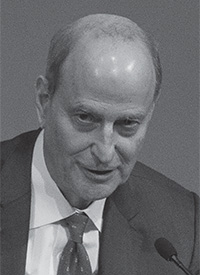
Paul LeClerc
Paul LeClerc is the Director of Columbia Global Centers, Europe and the Networking Chair. He was elected a Fellow of the American Academy in 2001 and serves as Chair of the Academy’s Commission on Language Learning.
My favorite family story about language learning has to do with a trip my wife and I took with our son, Adam, when he was two years old. We were driving to his grandparents’ house and passed a billboard with advertisements for Delta Air Lines flights to Florida. The symbol used to express the state of Florida was two gigantic flamingos. Judith said to Adam in the back seat, “Adam, look at those great big birds. Those are called flamingos. Can you say flamingo?” And he said, “Not yet.”
We are now in the process of thinking through just what ought to be the content of the Academy’s engagement in a new Commission on Language Learning in the United States. This commission, like the Academy’s landmark Commission on the Humanities, was formed in response to an explicit request by bipartisan groups within the U.S. House and Senate that we undertake a study of the nation’s language education needs.
Specifically, the Academy was asked by members of Congress to provide answers to the following questions. First, how does language learning influence economic growth, cultural diplomacy, the productivity of future generations, and the fulfillment of all Americans? Second, what actions should the nation take to ensure excellence in all languages, excellence in international education and research, and the effective use of current and future supplementary resources to advance language attainment? Any one of these mandates in and of itself would be the cause of an enormous amount of concentration and hard work on the part of any commission.
But before we get deeply into this work, the commission will have to resolve one important issue: the question of the acquisition of English language skills. My sense is that what Congress is asking us to do is to look at the acquisition of non-English language skills, which is certainly important in today’s increasingly globalized world context, as well as in the context of the gross inequalities that exist within our society and other societies as well.
But many native speakers of English in the United States, of all ages, lack competencies in one or more of the four language skills: speaking, reading, writing, and understanding. The reports that come out on a regular basis about the performance of school children on standardized tests are all you need to know that English language skills are terribly important to the future welfare of those children and indeed of the nation. So the extent to which we include English in our study is a question we will be discussing intensely at our first meeting.
We also need to keep in mind the increasing dominance of English as a world language. That it is already the language of business around the world helps to explain, for example, the extraordinary sum of money recently paid for The Financial Times (a significant multiple of what Jeff Bezos paid for The Washington Post a couple of years ago), as well as the assumption on the part of many Americans that as long as you can speak English and get along in English you don’t need to learn a non-English language.
English may well be, as one of my Academy colleagues says, the solvent language of the world, but I do not agree with the notion that if you do well in English you can get by anywhere in the world. And the attitude we face here in the United States is perhaps even worse than that. Consider the beating John Kerry took as a presidential candidate because he could speak fluent French, which was seen as effete and a negative.
The commission’s first task, therefore, will be to clarify our mandate and agree to the importance of considering all aspects of language education and language learning that are related to the congressional mandate or that we choose to add to that mandate. The commission includes members of the original Humanities Commission and the leaders of the Modern Language Association, the American Council for the Teaching of Foreign Languages, and other organizations that have a direct interest in the commission’s work. Also joining us are distinguished scholars in fields such as linguistics, modern and ancient languages, technology, and law, as well as the chancellor of UC Berkeley, an official from the Department of State, a former ambassador to Afghanistan, and so on.
In addition, a superb series of briefing papers has been commissioned by John Tessitore, who supports the work of the commission. The topics include America’s languages (promises and challenges and an overview); language and economic growth; language, cultural diplomacy, and global security; language and productivity for all Americans; and language and the happiness and fulfillment of individual Americans. If you are interested in assisting the commission in its work or would like to propose experts for the commission to consider, we would love to hear from you.
The Lincoln Project: Excellence and Access in Public Higher Education
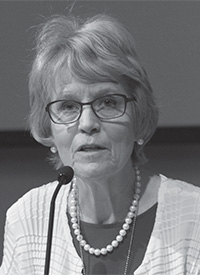
Mary Sue Coleman
Mary Sue Coleman is President Emerita of the University of Michigan and President-Elect of the Association of American Universities. She was elected a Fellow of the American Academy in 2001 and serves as Cochair of the Lincoln Project.
Since the Lincoln Project started a bit more than two years ago, we have issued two of our five contemplated publications. The first to be published addresses why public research universities matter. The second is now online and will soon be out in paper form; it explores changes in state funding for public research universities. We anticipate a third paper about university finances, a topic that is rather opaque to the general public. The fourth publication will discuss what impact public research universities have had, and our final publication, which we hope will come out in the middle of the election season, will offer recommendations for what we might do to address what we believe is a crisis in public research universities.
The Lincoln Project honors President Abraham Lincoln and his role in signing the 1862 Morrill Act, which laid the groundwork for the nation’s unparalleled public university system. That system resides alongside the system of private universities. Both are important in the spectrum of higher education offerings in this country, and we have no interest in creating a divide between the two sectors.
However, public universities and colleges, which we believe are key to economic growth, innovation, and upward mobility, are facing enormous challenges that have been developing over the last thirty or forty years and have really intensified over the last decade, particularly in light of the great recession. Part of the role of the Lincoln Project is to highlight these intense challenges.
Our wonderful project advisory group is drawn from the membership of the Academy as well as from the higher education sector, the government sector, the private sector, the high tech world, and news and media organizations. We have held regional meetings around the country for the last two years and have been excited to see examples of the enormous creativity that exists in the public higher education sector.
The first thing we had to decide was which cohort of universities we would study. We felt it was important for us to have an envelope around this so that the questions we were asking and the issues we were trying to address really related to the public research university. So we started with the Carnegie definitions. One hundred eight universities, both public and private, fall into the “very high research activity university” category; ninety-nine are in the “high research activity” category, and seventy-nine are in the “research university” category.
Among the universities in the very high research activity category and the high research activity category, 143 are public universities, and every state has at least one. This group became our study cohort.
We chose to focus on public universities in part because their broad distribution across the states (every state has at least one very high research activity or high research activity university) will make getting the public’s attention easier and because the private universities in the two highest Carnegie classifications, wonderful as they are, educate only 474,000 undergraduate students. The public universities in these two categories educate 2.75 million undergraduate students. This is a huge disparity and one of the reasons we believe it is so important to the nation that we find ways to preserve this sector.
A similar imbalance holds true at the graduate student level. The private universities in the very high research activity and high research activity categories educate 288,000 graduate students. The public universities educate 615,000 graduate students.
So what’s happened in student enrollment? Despite the devastating cuts in public higher education funding in the last decade, especially through the recession, public research universities have continued to increase enrollments and to educate more students than the private universities. Public research universities today are doing more with less.
At the same time, private research universities with large endowments have been able to lavish resources on students. This is a good thing. But it has put tremendous pressure on public research universities. Without comparable resources, they have had to restrain their costs and expenditures while still trying to educate students, keep quality high, compete with their public and private counterparts, and still serve the nation in the way we all feel is important.
So what about access? One of the reasons Lincoln signed the Morrill Act was to make higher education available to citizens of all types. How well are the public research universities doing in that regard? Arguably they are meeting the mandate. Almost 29 percent of their students are low income. The public universities also educate a higher percentage of low-middle-income and middle-income students.
In addition to educating students from across the economic spectrum, both public and private universities have been doing extremely well in graduating underrepresented minority students. This continues to be true on the public side even with the constraints public universities now face in admitting such students.
A constant theme in newspapers – you have all heard about it – is skyrocketing tuition. Why is this happening? What we have discovered is that almost 80 percent of the increase in tuition is a direct response to the dramatic decrease in state funding, a trend the Lincoln Project believes is irreversible. While we will do everything we can to urge the states to recognize their responsibility in this area, we don’t believe we can return to the day when states covered 70 percent of the cost of an undergraduate education and families covered 30 percent. The overall percentages are now almost reversed: families at 70 percent and the state at 30 percent or less, with some institutions receiving much, much less in state support.
What is causing this problem? The Lincoln Project’s second publication deals with the budget landscape higher education now faces. Elementary and secondary education – which is very important in this country – takes the lion’s share of states’ budgets. Medicaid – a fixed cost the states cannot avoid – is another major competitor for funds. Higher education and corrections spending are then almost neck and neck.
One of the things we found most interesting as we got into this study was the vast difference in how the states support public higher education. At the high end for per student expenditures were Alaska and Wyoming, each spending more than $16,000 per full-time-equivalent student. At the low end were Arizona and New Hampshire, each spending less than $4,000 per student. We would love to see the states set a floor, commit to a minimum level of support for higher education.
Another driver of increasing tuition has been rising pension costs. In Illinois, for example, recent increases in the higher education budget might lead you to conclude that public universities there are recovering. In fact, most of the increase has gone to pay for higher pension costs.
If we look at where else spending is increasing in state budgets, we find that one of the biggest growth areas is corrections, which will soon overtake higher education as an expenditure. That is, states may soon spend more to put people in prison than to educate them for the future. Already the state of Michigan spends more on corrections than higher education, and I think California does, too.
What did we conclude from our regional meetings? First, state disinvestment is a nationwide phenomenon. We would like to stop it, reverse it if we can, and we are going to talk about it at every opportunity, but we suspect it is irreversible. Second, disinvestments have been offset by increases in tuition. Third, commitment to access varies widely among states. Fourth, and something we found enormously encouraging, public research universities have reacted to the worsening conditions with a level of creativity that, frankly, surprised us; for example, they have been optimizing their position in the local context. That is an important outcome.
Something we hear a lot of talk about is technology and how it is going to reduce the cost of higher education. The most cited example here is online courses. A much more interesting dynamic, however, is how technology can help us learn more about students (for example, through data collection) in order to better personalize their education and track their progress. We think universities can effect dramatic improvements in graduation rates by improving their ability to know how students do in courses and using predictive analytics to help get them through their undergraduate education.
Other topics we are looking at are how to diversify funding and the importance of operational efficiency. Philanthropy will be a major part of the funding model for public universities in the future, so we need to understand what successful philanthropy
models look like and how to encourage foundations to look more to the public sector for their funding targets.
We also want to identify at the federal level some opportunities for increased public and private investment, and perhaps combined investment, in public research universities. And while we understand the social and the economic pressures the states are facing, we also believe they need to recognize the value of these universities and thus base future funding goals on an appraisal of how they benefit local communities, states, and the nation.
Universities themselves will need to take charge of operational efficiency, doing all they can to remain competitive with their private counterparts while addressing budgetary limitations responsibly and in such a way as to remain attractive candidates for both public and private investment.
Finally, the business world has benefitted enormously from what our public research universities produce: educated employees and consumers, and research and technology that spur innovation. So we are going to recommend more direct private investment in public higher education.
Commission on the Future of Undergraduate Education
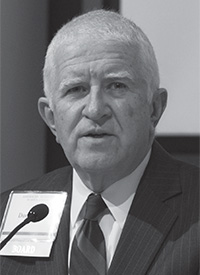
Don M. Randel
Don M. Randel, a Fellow of the American Academy since 2001, is Chair of the Board of the American Academy of Arts and Sciences.
The work of the Lincoln Project has made clear one aspect of the desperate situation in which higher education finds itself in this country. It represents a huge disinvestment on the part of the public in what ought to be a public obligation to the citizens of the country. I give you but one statistic. In 1995, the United States was ranked first in the world in the percentage of its citizens who held university degrees. By 2014, we had descended to number nineteen out of the twenty-eight most developed countries. This cannot be good for the future of the nation.
In the wake of the work of the Lincoln Project, the Academy believes we need to step back and take a view of higher education as a larger system, one that includes different kinds of institutions, and try to understand the relationship of these institutions to one another. One of the first and most pressing tasks in this work is to try to dispel the substantial amount of misinformation that emerges in the debate about higher education. A very great deal of what we read in the public press is either mildly or entirely misinformed about how the system works.
Simultaneously, we have to take into account the fact that we live in a nation with no national higher education policy. We have a Department of Education, and while the Secretary of Education has a few carrots, the office has absolutely no sticks with respect to how higher education goes in this country. The states and localities are left alone to do what needs to be done for public higher education, and there are wide disparities from one state or community to another.
The result is a system that reminds one of the Wild West. Instead of providing access to higher education broadly and funding it the way other developed countries do – namely, through a progressive tax code – we leave each of the 4,500 institutions of higher education – both public and private – to figure out how to redistribute income so as to enable the less well-to-do to have access to higher education along with the well-to-do.
The direction we are headed, in which the burden increasingly is placed on the backs of students and parents except in a few very wealthy institutions, leaves each institution to figure out how to do this on its own.
When we talk about the high cost of education, what is usually meant is how high tuition is without taking into account what the average student actually pays to go to a university, whether public or private. The discussion leaves out the fact that many private institutions that are thought to be wealthy are in fact discounting their tuition by 50 percent or more, and it leaves out the way in which the public universities are more and more forced to find ways to redistribute income in order to make good the loss of public funds.
So we increase tuition for out-of-state students in order to pay for in-state students. We increase financial aid out of the tuition paid by well-to-do students so as to make possible the education of the less well-to-do. We face the very real danger that higher education in America, instead of being the great force for the amelioration of income inequality, becomes a system that exacerbates income inequality.
The rich will always have places in higher education, and a few institutions will always be able to afford from their own resources to educate some modest number of the less well-to-do, but the system as a whole is in a deeply troubling situation, and unless something is done to reverse that we shall have only ourselves to blame for a declining presence in the world as a great leader – not only as an economic power but as a great leader in ideas and as a force for good for people around the world.
We love to brag about a certain group of distinguished private universities in this country, but the truth of the matter is that only four are truly wealthy institutions. (They start with the letters H, Y, P, and S.) Even institutions you might think have big endowments – six billion dollars or thereabouts – are deriving at best only about 15 percent of their annual income from those endowments. These institutions, which are leading privates, are as tuition-dependent as many of the institutions you have never heard of, and still they are doing the teaching and research that benefits the public right alongside the great public institutions.
The Commission on the Future of Undergraduate Education will therefore take a broad and deep look at the entire system of higher education, if system be the word for it, and try to understand how we can frame recommendations or, at a minimum, how we can get the attention of the public and dispel some of the terrible misinformation that has guided or not guided the public debate.
We have before us in Congress people who would like to get rid of the Department of Education altogether, people who think that the more you privatize the better, the less government the better. But somebody has to assume the responsibility for the future well-being of this country, which surely rests within higher education as much as anything. There is no more important issue before the public today than higher education, and the Academy will do its best to clarify the issues involved and to see a better set of outcomes than, alas, we can now contemplate.
Global Security and International Affairs
Committee on International Security Studies
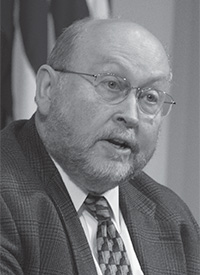
Steven E. Miller
Steven E. Miller is Director of the International Security Program at the Belfer Center for Science and International Affairs at the Harvard Kennedy School. A Fellow of the American Academy since 2006, he is Cochair of the Committee on International Security Studies and Codirector of the Global Nuclear Future Initiative. He also serves as a member of the Academy’s Council.
The Committee on International Security Studies is perhaps the longest-standing committee of the Academy. It originated in a summer study group that started in 1958 and then over a period of a several years did absolutely formative work in establishing the notion of arms control as a useful instrument of national policy in the area of defense. The group’s work led to a 1960 special issue of Dædalus that is usually described as “the bible of arms control.” Among the authors were Henry Kissinger, Thomas Schelling (later a Nobel laureate in economics), Paul Doty, and many other people who are regarded as giants in the field of arms control and nuclear policy.
After this initial period, the group transformed into a standing committee that has sustained itself for some five decades. Along the way the committee has addressed such issues as ballistic missile defense (“Star Wars”) in the 1980s, and questions of sovereignty and intervention in the context of Bosnia and the terrible crisis in southeast Europe in the 1990s.
In more recent years we have completed a major project on security among the post-Soviet states that emerged from the collapse of the Soviet Union, looking at how to reorder that space in a way that minimizes the likelihood of large-scale violence. We have also done work on the military uses of space, with the objective of creating structures of governance in what is otherwise an ungoverned environment.
We are just now launching two projects that will figure importantly in the next phase of the Committee’s work. One of these, led by Robert Legvold of Columbia University, will move forward under the heading “Understanding the New Nuclear Age.” In a way it harkens back to the same set of issues that animated our colleagues in 1960: how do we prudently and safely manage the nuclear technology that some of our intellectual forefathers vividly described as “species-threatening”? And how do we do so at a time when the deterioration in U.S.-Russian relations has produced something akin to the old Cold War sentiments?
Worse, many of the treaties, institutions, and policy frameworks that were employed during the Cold War to govern the nuclear relationship with Moscow either no longer exist or have been allowed to decay. The Anti-Ballistic Missile Treaty is no longer in effect because the United States withdrew from it. The strategic arms control process that structured the dialogue on nuclear issues between Moscow and Washington has been allowed to lapse. The partnership forged between Moscow and Washington on cooperative threat reduction to minimize the likelihood of loose nuclear weapons and materials has collapsed.
Governing structures have decayed even as many of the risks that were embedded in Cold War nuclear postures remain strikingly unchanged from Cold War days. So, this new project will consider how the nuclear relationship has changed, what risks we now face in light of current technological and geopolitical environments, and how we can revive arms control in such a way as to provide prudent management of what is the world’s most dangerous relationship.
The second project that is getting underway focuses on fragile states. In Syria, Libya, Iraq, Afghanistan, Sudan, Somalia, the Democratic Republic of Congo, we see acute human tragedies and intractable political land security challenges that arise from the inability of states to establish full sovereignty over their territories. When such states weaken and collapse, difficult challenges and painful choices are pressed onto the world community and onto the American national security agenda. What to do? What will work? Why does this happen? How can we remedy these problems?
Under the leadership of Karl Eikenberry
– now at Stanford University, former U.S. Ambassador to Afghanistan, and a retired U.S. Army Lieutenant General who served in Southwest Asia and has firsthand experience with some of the implications of failed states – we are going to look at why we are seeing this epidemic of state failure. What are the security challenges that arise when states begin to disintegrate? What policy options are available to the United States and the world to address these terrible security and humanitarian challenges? Can we divine from the historical evidence of recent experience some sense of what might actually work?
The Global Nuclear Future
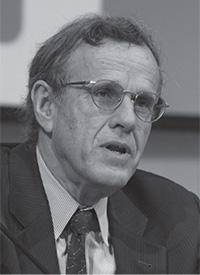
Robert Rosner
Robert Rosner is the William E. Wrather Distinguished Service Professor in the departments of Astronomy & Astrophysics and Physics at the University of Chicago, as well as in the Enrico Fermi Institute, the Computation Institute, and the Harris School of Public Policy Studies. A Fellow of the American Academy since 2001, he serves as a member of the Academy’s Council and as Codirector of the Global Nuclear Future Initiative.
The Global Nuclear Future Initiative is a great example of how you can be drawn into activities at the Academy. The project, started by my two colleagues Steven Miller and Scott Sagan, began with broad participation from individuals who are members of the Academy and from individuals who are not members, and with very generous funding from the MacArthur, Hewlett, and Sloan Foundations and Carnegie Corporation of New York.
So the key question, of course, is why this project? Clearly the nuclear renaissance has not happened in the United States, but it is happening in other parts of the world, in particular in the Middle East and in Southeast Asia, and so that has been the focus of our work. Specifically, we have been focusing on the question of how nuclear power can proceed in states that may not yet have the necessary technological and human resources to work with nuclear power in a way that we would regard as safe and secure.
In addition to a few legacy countries such as Japan and South Korea that have been major factors in the nuclear industry worldwide, we have focused on a group of countries where nuclear construction activities have already begun or are soon going to start. These include Vietnam, the United Arab Emirates (in particular, Abu Dhabi), Turkey, Jordan, and Malaysia.
The three foci of our studies are nuclear safety and liability; the question of what happens to used fuel once it leaves the reactors in countries that are typically not yet prepared to deal with it (what makes us nervous is that neither are we prepared; we have simply pushed the issue aside, and now we worry the same will happen in these countries); finally, the issue of nuclear terrorism and the problem of insider threats. No one of these issues is really distinct from any of the others. They are all interconnected.
Academics and Americans love to tell other people what to do; it is in our nature. But that behavior is not often welcomed, and because we understood this from the outset, we chose instead to engage with folks in a collaborative way. We have brought them into the discussions, and the publications we have produced are authored not just by us but also by them. We don’t just talk about the nirvana we would like to get to; we also talk about how we might get there. To encourage open, frank discussion, we operate on the Chatham House Rule and do not attribute particular statements to particular individuals. We try to maintain confidentiality.
As befits academics, we have done a lot of work and produced many publications, including two issues of Dædalus and a series of occasional papers published by the Academy and coauthored not just by us but by regional experts as part of the collaborative spirit we have tried to foster. We have organized regional conferences that involve the key stakeholders from government, from civil society, from academia. We have held policy briefings with government officials and representatives of the international nuclear industry.
Every year our agenda is full. Most recently, in January 2015, we were in Abu Dhabi looking at the site where the South Koreans are building four nuclear plants, discussing with the nuclear regulator in Abu Dhabi how they are going about things. We have dealt with a spectrum of similarly interesting issues, from governance to business models to dual use to interim storage of used fuel.
Our next steps include developing a model legal framework for bilateral or multilateral interim storage facilities and consolidating a partnership with the ASEAN countries to develop a regional roadmap for nuclear safety, security, and nonproliferation. We also plan to publish a book on the best practices for managing insider threats and an analysis of contemporary dual-use governance strategies.
New Dilemmas in Ethics, Technology, and War
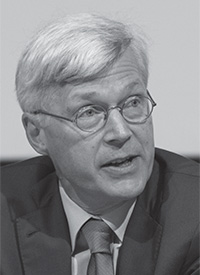
Scott D. Sagan
Scott D. Sagan is the Caroline S. G. Munro Professor of Political Science and Senior Fellow at the Center for International Security and Cooperation and the Freeman Spogli Institute at Stanford University. He was elected a Fellow of the American Academy in 2008 and serves as Chair of the New Dilemmas in Ethics, Technology, and War project as well as a senior advisor to the Global Nuclear Future Initiative.
Technological developments and changes in the nature of the conflicts we are engaged in have led to many challenges to our efforts to follow the laws of armed conflict and the principles of just war doctrine. Advances in precision-guided munitions placed on drones, for example, not only enable us to target individuals with far more accuracy and discrimination than ever in the past, leading to reductions in collateral damage, but also provide temptations to use that force in more places more often, potentially leading to larger amounts of collateral damage.
Understanding that many technological developments and changes in the nature of conflicts are poorly understood, the Academy has gathered together a very interesting group of individuals, interdisciplinary in nature, mixing practitioners and scholars with a wide range of people: scientists and soldiers, theorists and theologians, poets and pilots.
Next year the Academy will publish two issues of Dædalus that feature essays written by some of the members of the New Dilemmas in Ethics, Technology and War project. Many of the articles will be normative in subject matter, but empirical in orientation. That is, many of the authors are focusing not only on what soldiers and statesmen should do from a normative perspective, but also on how soldiers and statesmen actually behave in war. They include political scientist Joseph Felter from Stanford, who with Jacob Shapiro from Princeton is studying whether the efforts of the U.S. military to reduce collateral damage in Afghanistan and Iraq, by employing what was called the “doctrine of courageous restraint,” produced the hoped-for result of decreasing Taliban recruitment in Afghanistan and increasing the willingness of local villagers to provide information to the allies. Did that happen or didn’t it? Similarly, Brigadier General Mark Martins, the chief prosecutor at Guantánamo in the Khalid Sheikh Mohammed trial, is writing a paper on war crimes trials. When do they work and when do they potentially backfire? What does the historical record tell us?
Tanisha Fazal, a political scientist at the Peace Studies Institute at Notre Dame, is writing about what we know about when and why some insurgent groups, some rebel groups, follow the laws of armed conflict and others do not. What empirical information do we have, and how do we explain those differences?
Lloyd Axworthy, the former Foreign Minister of Canada, and Walter Dorn, a chemist at the Royal Military College in Canada, are writing a joint paper on improved warning indicators for civil strife that could lead to civil war.
Paul Wise from Stanford and Jennifer Leaning from Harvard are two medical doctors in our project trying to understand how best to predict emerging conflicts and to predict the consequences of such wars. It is important to note that there are often serious postwar failures in a country’s medical services, costs that are rarely understood in advance of war. If we systematically underestimate the long-term medical costs of war, shouldn’t we take that into account when we think about proportionality not only during conflicts but especially when contemplating whether to use military force at all?
Jennifer Welsh, the United Nations Secretary-General’s Special Adviser on the Responsibility to Protect and a professor at Oxford and the European University, is writing on the responsibility to protect doctrine of the United Nations and how it is changing given the experience of the Arab Spring and the great difficulties that followed.
Janne Nolan from George Washington University and Antonia Chayes from Tufts are writing a paper that focuses on questions of responsibility after war and what we know and now think given the recent war experiences of the United States.
Finally, the project has included prose writers and poets to broaden our perspective. At our recent authors’ workshop at Stanford, Phil Klay and Natasha Trethewey considered how literature reflects our common memory and how humor can be used to help soldiers deal with the activities they have engaged in and the horrors they have seen in war. Phil Klay is a Marine Corps veteran of the Iraq War and a National Book Award winner for his wonderful collection of short stories, Redeployment. Natasha Trethewey is a former U.S. poet laureate, a member of the Academy, and a Pulitzer Prize winner for Native Guard, a book of poetry written in the voice of a black Civil War soldier who is guarding former slave owners in a Confederate prison run by the Union Army in Louisiana. We need such perspectives to ground our understanding of just and unjust wars in the real experiences of men and women on the battlefield and behind the lines.
New Dilemmas in Ethics, Technology, and War
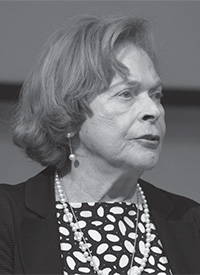
Antonia Chayes
Antonia Chayes is Professor of Practice in International Politics and Law at The Fletcher School of Law and Diplomacy at Tufts University. She is a member of the Academy’s project on New Dilemmas in Ethics, Technology, and War.
What comes next? This is the question we are asking as catastrophes unfold from Mosul in Iraq, Kunduz in Afghanistan, and throughout Syria. The essay that Janne Nolan and I have written for the project on New Dilemmas in Ethics, Technology, and War attempts to understand and explain how the United States and its allies fail to plan for the aftermath of conflict. This is both a failure of strategic analysis and a major ethical issue.
As Michael Walzer has written, “the argument about ending is similar to the argument about risk.” Once we have acted in ways that have significant negative consequences for other people, even if there are also positive consequences, we cannot just walk away.
Imagine a humanitarian intervention that ends with the massacre stopped and the murderous regime overthrown but with the country devastated, the economy in ruins, the people hungry and afraid because law, order, and any effective authority have vanished. The forces that intervened did well, but they are not finished. How can this be? How can victory be declared until some measure of recovery is achieved and the state can be accepted into the international community?
Likewise, logic would seem to require that, in debating how to respond in another country, policy-makers also analyze the consequences of nonintervention or even providing military assistance and training. If a nation collapses into chaos, sending refugees streaming throughout the world, what ethical or strategic objectives do stable governments have?
Nor are these all recent failures. In the United States the aftermath of the Civil War was not thought through. The dire reparations after World War I generated resentment among Germans who did not believe they had started the war or been defeated. Even the end of World War II, crowned by the Marshall Plan, almost succumbed to the draconian measures of the Morgenthau Plan, which would have dismantled German industry and reduced the country to an agrarian economy with reduced territory. The first Gulf War, touted as a success, left a sectarian residue to fester. And Iraq 2003 is a canonical case of military myopia and unrealistic optimism.
Why all these failures to learn? Systems are in place in the United States and the National Security Council, in the un Security Council, and in allied capitals, but they are underutilized. In our forthcoming paper we examine a few possible explanations.
First, the United States continues to rely on its advanced technology and fails to look beyond. Also, our constitutional system makes adaptation difficult once a consensus has been put together – a topic about which Janne has written a whole book. Deep civil-military dialogue is lacking, and diplomats are uncomfortable with systematic planning – a topic that I discuss in my book Borderless Wars. Bureaucracy continues to exercise its repertoire, as both Robert Komer and Graham Alison have described. Donors look to international legitimacy, and while they seek self-protection from further conflict, they fall short even of that goal. No one is in for the long term.
Investment in postconflict societies often seems difficult, but it is still cheaper than maintaining an occupation force for years beyond local tolerance. In the end, jus ad bellum, the decision to engage in a just war, does require jus post bellum, full consideration of what comes next.
Science, Engineering & Technology
Science, Engineering & Technology
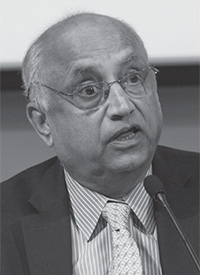
Venkatesh Narayanamurti
Venkatesh Narayanamurti is the Benjamin Peirce Research Professor of Technology and Public Policy at Harvard University. He was elected a Fellow of the American Academy in 2007 and serves as a member of the Academy’s Board of Directors and as a member of the Academy’s Council.
In 2008, the Academy published a report addressing two key issues: the support of early career investigators and the encouragement of high-risk, high-reward research. The project was called Advancing Research in Science and Engineering, or ARISE for short. The study’s recommendations were addressed to the major funding bodies – the U.S. Department of Energy, National Institutes of Health, National Science Foundation – and encouraged them to increase support for early career researchers and transformative research. The findings were incorporated into the American Research and Reinvestment Act as well as subsequent federal legislation.
Five years later the Academy published a follow-up report called ARISE II: Unleashing America’s Research and Innovation Enterprise. The project committee, which I chaired with Keith Yamamoto from the University of California, San Francisco, examined the U.S. research system with a special focus on the research university and two critical stakeholders: federal funding agencies and industry.
At the time, we were seeing a tremendous change in the scientific landscape; namely in the physical sciences and engineering and in the life sciences and medicine. Because of advances in the areas of computational biology, systems biology, and biologically inspired engineering, we concluded that much stronger bonds need to be forged among these diverse areas. We labeled this deeper union “transdisciplinary research.”
The physical sciences and engineering in academia have a long history of transferring knowledge to and working with industry. This was especially the case with the great industrial laboratories of the past. But changes in industry have placed these connections under great stress. We concluded that new models of collaboration between academia, government, and industry are needed to bridge these areas and that interdisciplinary research needs to become transdisciplinary research.
This past year the Academy published Restoring the Foundation: The Vital Role of Research in Preserving the American Dream, which was produced by a panel cochaired by Neal Lane and Norman Augustine. The report assesses the health of the research system and concludes that the country is falling behind in various ways. For example, research funding has not kept pace with our gross domestic product, and innovation policy has not kept up with the work of academia and industry.
Among the panel’s recommendations are three overarching prescriptions. The first is to secure America’s leadership in science and engineering research, especially basic research. To do so, we need to develop sustainable, long-term investment goals – a certain percentage of the GDP probably should be going toward basic research, for example. Second, we need to ensure that the American people receive the maximum benefit from publicly funded research. Third, we need to establish a new, robust partnership among academia, industry, and government.
New Models in U.S. Science and Technology Policy
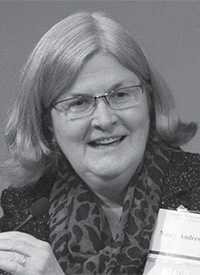
Nancy C. Andrews
Nancy C. Andrews is Dean of the Duke University School of Medicine and Vice Chancellor for Academic Affairs. She is also the Nanaline H. Duke Professor of Pediatrics and Professor in the Department of Pharmacology and Cancer Biology. She was elected a Fellow of the American Academy in 2007 and serves as a member of the Academy’s Board of Directors. She is also a committee member for the New Models for U.S. Science and Technology Policy study.
Restoring the Foundation asserts that American science, engineering, and technology research is at a critical inflection point and that the decisions of policy-makers and leaders over the next few years will determine the trajectory of American innovation for years to come. The report describes the challenge that lies before us and is meant to serve as a call to action. In the words of Norman Augustine, who cochaired this report with Neal Lane, we must start to think about our future if we hope to have a future.
Looking back, America’s post – World War II rise to international preeminence in science and technology was truly remarkable and attributable to decades of investments made in research and education. We see the benefits in our own lives. Our life expectancy in America today is nearly twice that of our grandparents because devastating infectious diseases have been conquered and conditions like cancer and coronary artery disease are much less likely to be lethal.
Because of basic scientific research, we carry pocket devices that not only let us communicate from almost any place on earth – and take selfies – but they can instantly provide more information than most libraries. The past seventy years of research and innovation have also provided enormous economic benefits: new efficiencies, new businesses, and new careers.
But America’s future does not look as bright. We can no longer claim preeminence in a number of areas that we have taken for granted. Our students now rank seventeenth in the world in reading, twentieth in science, and twenty-seventh in math. As a country, we are seventh in the world in basic research investment, and we have dropped from first to tenth place in total r&d investment.
As our investment has languished, other countries have recognized how vital a strong research enterprise is for economic growth and for their citizens’ quality of life. In less than ten years, if current projections hold true, China will outspend the United States in research and development both in absolute terms and relative to the overall economy.
The rest of the world is now trying to emulate what America once did.
Technological advancement relies on breakthrough discoveries that come out of fundamental curiosity-driven basic research, most of which is government funded. Innovators and entrepreneurs create new jobs for a broad spectrum of Americans, and they could not do so without basic research. Yet since 2003 the federal basic research investment, as a percentage of the GDP, has dropped by 13 percent, and the funding landscape has become a roller coaster.
We risk losing the advantage America has long held as an engine of innovation – an engine that not only generates new knowledge and products but new jobs and industries. Business agrees. The project committee for this report consists of twenty-five leaders from all corners of the research enterprise, from government, universities, and corporations.
At its release, Restoring the Foundation was immediately endorsed by Merck & Co. and by the Business Roundtable. The Council on Competitiveness, which represents CEOs of major corporations, university presidents, and the heads of national labor organizations, supports our message. They agree that any national strategy addressing jobs and the economy must have a focus on innovation and competitiveness.
In February a closed-door roundtable was held in the U.S. Capitol Visitor Center that brought together nearly thirty CEOs and NGO presidents with a bipartisan, bicameral group of congressional members. The event was organized in coordination with Senator Chris Coons’s office and was attended by Representative Randy Hultgren, Representative Derek Kilmer, and Senator Dick Durbin. Senator Lamar Alexander was unable to be present but wrote a brief statement of support that was delivered at the meeting.
Those in attendance expressed broad agreement that basic research investments are critical for industry and the economy and that it is the role of the federal government to make those investments.
Over the past year, the Academy has organized dozens of meetings across the nation and in our nation’s capitol. Committee members have been invited to present the report at professional society meetings and to federal agencies. They have participated in more than fifty meetings with members of Congress and their staff, including congressional briefings.
Recently, Restoring the Foundation cochair Norman Augustine was invited by the Senate Commerce Committee to participate in a roundtable discussion to identify priorities for the Senate version of the 2015 America Competes Act. Norm and his Restoring the Foundation cochair, former White House Science Advisor Neal Lane, also submitted a letter addressing Commerce Committee questions on how to maximize the impact of basic research. The invitation for the Academy to participate in these conversations signals Senate leaders’ recognition of the work of Norm, Neal, and our entire Restoring the Foundation committee.
Restoring the Foundation also inspired the statement “Innovation: An American Imperative,” which supports many of the report’s recommendations. Nine CEOs of major corporations signed on, including Marillyn Hewson from Lockheed Martin, Jim McNerney from Boeing, Sam Allen from John Deere, and Satya Nadella from Microsoft. Many universities and academic societies also signed.
The American Academy is working with ten other organizations, including the American Association for the Advancement of Science, the Association of American Universities, and the Association of Public and Land-Grant Universities, to organize an event in Washington on October 20, 2015, to call greater attention to this statement and to the report recommendations. Norm Augustine will be speaking along with Jeannette Wing from Microsoft and Roger Perlmutter from Merck. We are gratified that so many other organizations have joined the Academy in carrying the report’s recommendations forward. The Academy will continue to work with our partners in the years ahead to bring greater visibility to key policy issues pertaining to basic research both in Washington and across the nation.
Public Understanding of Science
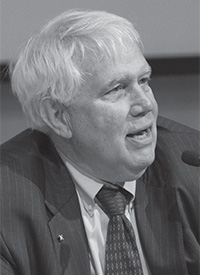
Richard A. Meserve
Richard A. Meserve is Senior Of Counsel in the Washington, D.C., office of Covington & Burling LLP. He is President Emeritus of the Carnegie Institution for Science and previously served as Chairman of the U.S. Nuclear Regulatory Commission. He was elected a Fellow of the American Academy in 1994 and serves on the Academy’s Council and Trust. He is also a member of the advisory committee to the Academy’s Global Nuclear Future Initiative and of the Science and Technology policy study group.
I think all of us are aware of the great significance of science and technology in our lives. They affect personal decisions we make about our healthcare and what we eat, and they have enormous importance for a wide range of crucial public issues such as climate change, the future trajectory of energy and water usage, how we deal with a growing world population, protecting endangered species, and on and on.
People in the scientific and technological world can provide information on those topics to ordinary citizens to help them make important decisions. As a result, the interface between scientists and the public is crucially important, but we confront challenges in assuring adequate information flow. The Academy is thus embarking on a new project that is intended to deal with these challenges.
Data from the Pew Research Center show that, despite a slight decline over time, the public has a generally positive view about the contribution of science to society. The vast majority of people believe that science has made life better for most people, and they have a favorable view of the contributions of science and technology to healthcare, food and the environment, economic development, and many other areas. The Pew data also show that scientists are among the most respected professionals in the United States.
The foundation for communication with the public on scientific and technical issues is thus strong. The problems arise when you turn to specifics. For example, an astonishing fifty-one-point gap exists between what scientists understand about genetically modified foods and what the public thinks. Similarly, there is a forty-two-point gap concerning the use of animals in research and an almost identical gap in views of the safety of foods grown with pesticides.
The data show that 65 percent of the public believe human beings evolved over time, but only a third of the public believes that human evolution was guided by natural selection. Many respondents have the view that a supreme being controlled evolutionary change.
Other issues, too, show gaps between what the public understands and the views of the scientific community: whether childhood vaccines should be required (an 18 percent gap), whether climate change is due to human activity (a 37 percent gap), or whether a growing human population will be a major problem (a 23 percent gap).
One should not assume, however, that scientists are universally in favor of all technology. The scientific community is more pessimistic than the public about, for example, whether astronauts are essential for the future of the U.S. space program or whether we should undertake increased offshore drilling for oil or should further exploit fracking to recover natural gas. In each instance, the scientific community has a more negative view than the public of these activities.
It is no doubt the case that a core problem relates to science education – namely, the reality that the public doesn’t understand science because they haven’t been taught well enough. That is a foundational problem. And while science education is no doubt the most significant factor in the gulf between the understanding of scientists and that of the public, the data show that other factors are at play too.
For example, attitudes about evolution are affected by religious beliefs. Climate change issues are strongly correlated with political ideology and age. Men and women differ on the use of animals in research and on various energy questions. No doubt many other factors also affect how receptive people are to scientific information.
The intent of the Academy’s new project is to understand at a much deeper level than we do today the issues of trust, engagement, and perception that impact the interface between scientists and the general public.
The aim is to understand the factors that affect the public’s willingness to accept knowledge from the scientific community. The work will involve scientists and technologists, but it should also draw from a broad segment of the Academy, including members who are involved in education, communications, and journalism.
Probably a critical factor is the way in which scientists engage with the public. Scientists often have a difficult time describing their fields to the general public. Many scientific fields use specialized language that experts grow accustomed to using and then have difficulty avoiding in public communications. Moreover, scientific experts fear oversimplification without recognizing that there may be nuances that are of great significance within the field, but are irrelevant or tangential to the general public.
Another challenge for the public is the determination of whom they should believe. Members of the general public who want information may not know how to identify reliable sources or make sense of experts’ dueling claims (a challenge we frequently confront, for example, in the public discussion of climate change). You can find support for nearly any proposition on the Internet, which only compounds the problem of distinguishing a reliable from an unreliable source. An additional complication is that scientific positions evolve over time. The apparent inconsistency in scientific consensus can impact the public’s confidence in scientific information. Witness, in this regard, the constantly changing guidance of foods to eat or avoid.
The media are an important intermediary between the scientific community and the public. As part of the project, there will be opportunities for Academy Fellows to interact with young, talented journalists – for example, through the Knight Science Journalism program at MIT or with the Nieman Foundation Fellows at Harvard – to explore means to improve communication. But we will have to reach out to a broader community, too, because traditional newspapers are no longer the only important sources of information for the public.
Lastly, we contemplate exploring issues that relate to how scientists are consulted during public decision-making processes. For example, what is the role of science in the legal system? What are the barriers to effective engagement? What role can science play both during man-made and natural disasters and in preparing for such disasters? We have been interacting with the U.S. Department of the Interior to consider how we might better use science both ahead of time and during an accident to guide government actions.
The Public Understanding of Science project is still in the gestation phase. And because it is such an important project, I invite all of you to get involved in shaping it or in contributing your expertise.
Exploratory Projects, Projects under Consideration, and the Future
Exploratory Project: Access to Justice
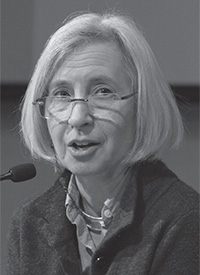
Martha Minow
Martha Minow is the Morgan and Helen Chu Dean and Professor of Law at Harvard Law School. She serves as Vice Chair of the Board of the Legal Services Corporation. She was elected a Fellow of the American Academy in 1992.
Despite constitutional commitments to equal justice for all in this country, access to justice has actually declined in the United States in the last ten years. Income and status sharply affect the nature of justice and the experience of justice in America, and the Academy’s attention, we believe, can make a real difference in this crisis that is affecting both civil and criminal justice.
We will be hosting a conference at the Academy on November 11 and 12 that will bring together judges, lawyers, and legal scholars concerned about the state of legal services for low-income Americans. The Constitution guarantees access to a lawyer when someone faces jeopardy and the loss of his or her liberty, but that guarantee, while beautiful, has not been delivered in practice. Many people around the country who face jail time have no lawyer at all. Many are pressured to bargain for some kind of reduction in charges without any lawyer to give them advice.
Few jurisdictions comply with the most recent Supreme Court judgment on the subject, Alabama v. Shelton in 2002, which guaranteed a right to counsel for people receiving probation or suspended sentences. Only a few jurisdictions have the ability to provide counsel in those circumstances. And even where lawyers are provided, often it is in name not reality.
Public defender caseloads so far exceed the national standard of no more than 150 felony cases per attorney, and that is an embarrassment. New York State is one example where the standard caseload is twice the national stated goal. But that is actually better than most jurisdictions. The typical caseload for public defenders in the United States is 1,600.
This is a crisis and results in miscarriages of justice every day. Triage is inevitable. Any public defender’s office is like a battlefield, and the shortfalls in quality of representation are nothing short of shocking. And this doesn’t even reach the question of whether the right to public criminal defense includes access to investigators, to scientific testing – all of which costs money.
The criminal justice system does not work the way it is portrayed on television. We do not have trials. We do not have CSI and CIS as routine resources. Thus, in the daily routinized criminal plea bargains and scattered trials in this country, we do not have that kind of evidence and that kind of defense. The government commonly spends three times as much to prosecute a case as it spends on public defense, and that is in the best scenario – in cases where there is a public defender.
Even when an indigent defendant has access to a public defender, there is a fair question about the independence of the public defenders. Studies show that in some parts of the country the public defenders are not independent. They face political pressures to accept pleas or to handle individual cases in particular ways. Public defenders particularly lack independence when it comes to any decision that affects resources, such as access to investigators, to DNA testing, or to any other kind of expenditure.
These difficulties are embedded in a larger criminal justice system that is going through a severe crisis resulting from a lack of training for law enforcement. We have all watched the tragic shootings of individuals across America by law enforcement officers who lack training or who may feel their own lives are threatened and don’t understand how to manage those threats.
The patterns of racial disparity are so staggering and shocking they are affecting our standing in the world, not to mention our conscience. And that is all in the context of the contemporary United States having the dubious distinction of being the most incarcerated country in the history of humanity.
The Department of Justice issued a powerful report identifying how in Ferguson, Missouri, the criminal justice system is dependent on court fines, producing incentives for more arrests and more punishments. Despite laws against debtors’ prisons in America, we do have debtors’ prisons in America. These are deep, deep problems.
The civil justice side is not any better. We have record levels of people in poverty in America right now, and yet in the last few years we have seen a reduction in support for low-income people seeking access to justice. In just the last year, 54 million people became eligible for legal services in America. We have resources for maybe 20 percent of those, meaning at best a phone call or other very limited assistance.
Most people who have a low income also have other challenges in their lives. They face eviction and foreclosure; they face problems accessing healthcare or disability benefits or veteran’s benefits. They need help with domestic violence protection orders; family law matters such as divorce, child custody, or child protection; immigration status; and employment and wage protection.
Violations of civil justice happen every day in America, and people without money have few avenues to do anything about it. The federal program to support legal services was developed when Richard Nixon was president; it had bipartisan commitment. In the last four years, however, its funding has declined by 20 percent. In real dollars we now spend less than a quarter of what we spent during the Nixon administration.
Nearly sixty legal services offices closed in the last year because of the declines in funding. In civil cases, there is no constitutional right to legal representation. Low-income individuals and often middle-class individuals have to represent themselves in court. Levels of this “self-representation” are at 80 or 90 percent in some areas of the country. Trial judges report that unrepresented litigants fail to present evidence, perform ineffective cross-examination, and make fatal errors in representing themselves; some estimate that such fatal errors by self-represented litigants arise in 60 percent of such cases.
Even if we didn’t care about such unfairness as a matter of conscience, it turns out that failing to invest in civil justice is an expensive proposition. Lack of civil representation means rights go unenforced; delays and inefficiencies mar the entire system; and costs mount up for local communities. Not only is it the right thing to do; it is the smart thing to do because evidence shows that investing in access to legal assistance saves money.
Here in Massachusetts I served on a commission that demonstrated that for every one dollar spent on civil legal assistance the Commonwealth saves five. New York found that for every one dollar the state saves six dollars. How is this so?
The savings are realized in preventing homelessness, in securing federal disability or health benefits for which people are qualified, in helping people get child support orders enforced, in helping people pay their bills, avoid eviction, manage or prevent foster care placements. Prevention is cheaper than the consequences of not preventing terrible disasters for poor families.
Keeping a child with special needs in school, for example, can make all the difference in whether a parent can go to work. But if we don’t actually pay to make sure the child gets the right placement, the family’s finances can unwind.
One of the better federal programs developed to deal with civil legal assistance is in crisis because of the overall economy. The program – called iolta (Interest on Lawyers Trust Accounts) – is funded by the interest generated when lawyers hold a client’s funds. If you have any idea of where interest rates have been lately, you will understand why this wonderful program has plummeted as a source of support.
We must look at new solutions. Possibilities include better leveraging of pro bono services by lawyers, including establishing partnerships with law firms, law schools, and companies. Perhaps most exciting are the prospects for technological innovation. Many courts are experimenting with the use of digital access to justice. This could include digital document assembly, mobile apps, or digital forms with an interactive AI (Artificial Intelligence) that individuals can consult as they pursue their claims. More profoundly, it could mean the use of business processes to address inefficiencies in people’s access to justice. Fields like business, medicine, consumer relations, and even the drone industry have already leapt way ahead in the use of digital technology. These hold lessons for law.
Translation services are another great example. Access to justice for people whose primary language is not English is a critical problem. Artificial intelligence language translation can put the legal system within reach if we can figure out how to actually connect the individuals and maybe teach the programs some legal terms. The translation of “law-speak” into plain English for those who already speak English would also be a useful reform.
At our meeting at the Academy in November, we will examine the extent of the crisis. Our participants will include justices from state courts, as well as lawyers on the front lines and researchers. We will examine the pro bono and corporate lawyer contributions. We will also consider the potential for non-lawyers to provide legal services, even though that is somewhat of a “third rail” for the legal profession; it is something we have to think about given the scale of the challenges.
We will also examine reforms in the judicial system itself and will look at insights from the forty justice commissions that have been convened around the country. As we move forward, we have a dire need for data. Knowledge about how access to the justice system actually works is limited. And we cannot solve this problem until we improve that situation.
I have had the privilege of working in this field for a long time. I have also worked in post-conflict societies, and I can tell you that if you don’t have respect for the rule of law, if your society doesn’t have regard for fundamental fairness, you are setting up a world that is likely to lead, if not to civil war, at least to civil unrest. If you don’t have courts that can resolve disputes, you won’t have businesses that are willing to invest. If you don’t have a legal system that appears legitimate, you invite self-help, disputes, and violence.
Finally, rights are not self-enforcing. We have a superb Constitution, but it doesn’t mean anything unless it is enforced. By neglecting the issues surrounding access to justice, we are hollowing out the public good that is our legal system and the rule of law.
Projects under Consideration
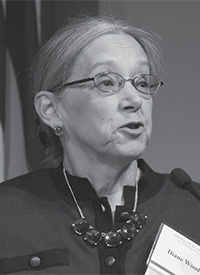
Diane P. Wood
Diane P. Wood is the Chief Judge of the United States Court of Appeals for the Seventh Circuit and a Senior Lecturer at the University of Chicago Law School. She was elected a Fellow of the American Academy in 2004 and serves as the Chair of the Academy’s Council, Vice Chair of the Academy’s Board of Directors, and as a member of the Academy’s Trust.
How is the Academy’s longer-term horizon defined? By what process do we choose the projects and studies that move forward?
This is the job of the Academy’s Council. We are advised by a Committee on Studies and Publications that examines each proposal in detail, thinks about what to do to bring it into focus, and considers whether it has the prospect of being a good study for the Academy. The Board of Directors, in order to make this a more transparent process, has approved a set of considerations that we think capture well what informs the selection of projects and studies.
Recently the Council has been discussing an initiative that would seek to enhance our understanding of the new nuclear age in which we live, building on the Global Nuclear Future Initiative. The purpose of this project would be to see whether the current nuclear age differs from previous ones and, if so, how. How has technological innovation changed things? How should we be thinking about nuclear arsenals as opposed to conventional arsenals? How might the mounting geopolitical rivalries among states with nuclear weapons affect the sustainability and stability of our global nuclear order?
Another principal mission of the Academy is the study of American institutions. What makes us a functioning democracy? How do we educate citizens? How should we think about preparing citizens for the future? What do we mean when we talk about education? Have we educated people if they are competent in mathematics and they know how to read, or do we need to include civic education of some kind – history and other things that make an informed and active citizen?
These and similar questions have led us to consider a new project on the education of the American citizen, one that would draw on the work we have been doing in the sciences, social sciences, and humanities. The idea has not yet crystalized into a project, but it is something that will give you a glimpse of how we look at the medium- to longer-term horizon.
Impact of Academy Projects
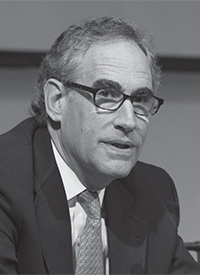
Alan M. Dachs
Alan M. Dachs is President and Chief Executive Officer of Fremont Group, a San Francisco-based investment firm. He was elected a Fellow of the American Academy in 2007 and serves as Chair of the Academy’s Trust and Vice Chair of the Academy’s Board of Directors.
“Not everything that counts can be counted, and not everything that can be counted, counts.” As someone who makes his living in commerce and who is measured almost every day, I offer this quotation, attributed to Albert Einstein, to put at ease those who are engaged in more intellectual pursuits.
I am fairly broad minded about what constitutes impact. I would argue, for example, that everything the Academy does has impact. If a couple of us are sitting around a table, perhaps listening to a poem or engaged in conversation about the human condition, that has impact on an individual basis at least. It may bring joy or concern or inspiration, and that, in my view, is impact.
At the other end of the spectrum we get much closer to my daily experiences: how do you measure impact, and what do you do with it once you have decided you have something that can actually make a difference in the world on a broader basis? These are questions we are trying to answer.
Many of the Academy’s projects that you heard about today contemplate the transfer of knowledge and research into the public domain with the goal of changing behavior. Many of the Academy’s commissions have also been working for a number of years, so it may take more than a month, more than a year, maybe more than three years for us to realize the full impact of what we do here.
The Academy has three governing bodies: the Board of Directors; the Council, which is concerned with the Academy’s intellectual pursuits; and the Trust, which has been assigned the task of measuring or determining impact. My hope, and I think it is shared by my colleagues, is that we don’t think of these as three separate organizations. The Council and the Trust should be interwoven at some level so that they can inform one another’s work in a way that makes it much more interesting and gives it a greater chance for impact.
But as we go forward and think about what constitutes impact and how to measure it, we should never become so confident in ourselves as to forget that things that can’t be measured also count.
© 2016 by Paul LeClerc, Mary Sue Coleman,
Don M. Randel, Steven E. Miller, Robert Rosner, Scott D. Sagan, Antonia Chayes, Venkatesh Narayanamurti, Nancy C. Andrews, Richard A. Meserve, Martha Minow, Diane P. Wood, and Alan M. Dachs, respectively